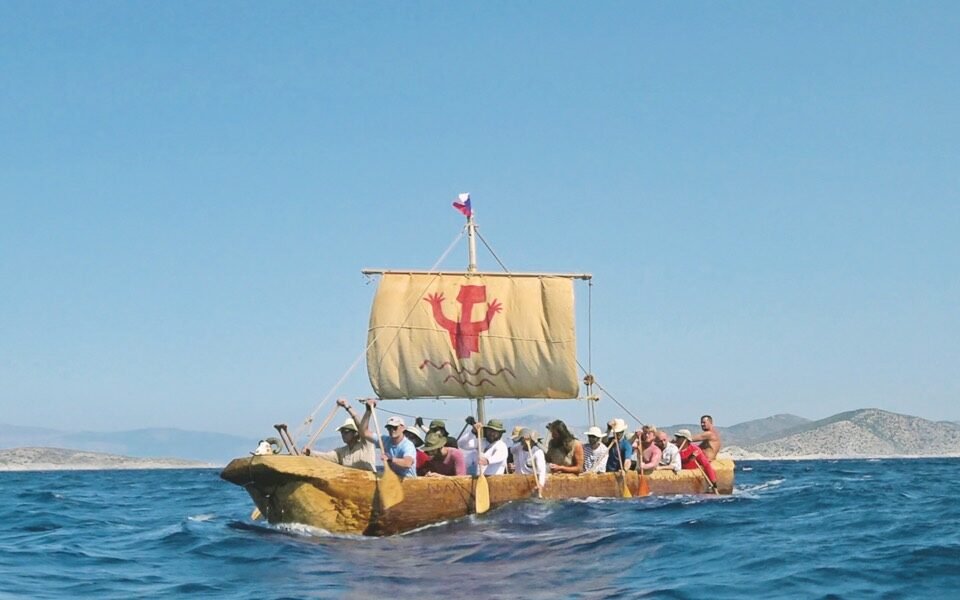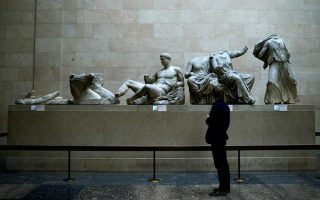Sailing the Aegean trade routes, Neolithic-style
Czech team carries out an expedition of exploratory archaeology in a dugout boat

The Aegean has been a sea of commerce ever since the dawn of the Neolithic Age, and obsidian was one of its most sought-after and valuable exports.
Found only on the islands of Milos, Antiparos and Nisyros, the tough volcanic rock was treasured by our Neolithic forbears because it was the perfect material for all those tasks that required sharp and durable tools. They used it to make blades, spearheads, axes and much more, which is why it was in such great demand even beyond the Aegean.
In fact, such blades discovered at Neolithic sites in mainland Greece (including Schisto and Argolida) were found from a string of scientific tests to have been made with obsidian from Milos.
The Neolithic islanders were nautical well before – 5,000 years, in fact – Pericles’ Athenians and Themistocles’ “wooden wall,” and a couple of years ago a team of Czech archaeologists set out to explore whether the type of boat they used was a “monoxylon,” a canoe-style vessel hewn from a single tree trunk and steered by oars.
‘We cut, carved and shaped the great oak trunk, originally weighing 14 tons, into a boat with truly impressive dimensions’
How they went about proving their hypothesis was as simple as it was crazy: building their own boat, manning it themselves and sailing the ancient trade route from Samos in the eastern Aegean to the coast of Argolida in the northern Peloponnese. The expedition set off in mid-June and successfully reached its destination in mid-July.
“Only thanks to a lucky coincidence we managed to obtain the massive trunk of the 300-year-old oak which had been ripped out from the ground by a violent storm in the forest enclosure named Mochov near the town of Opocno. There, it grew for hundreds of years, looked after by the local foresters,” the team said on its website.
“We cut, carved and shaped the great oak trunk, originally weighing 14 tons, into a boat with truly impressive dimensions. The production of the boat took about 1,000 working hours. A third of its length was worked on using stone tools as would be used during the Neolithic era, and the remaining parts were done by modern tools, which were used to save time,” the team explains.
The Czech team, which called itself Monoxylon, has carried out three smaller expeditions in 1995, 1998 and 2019. The expeditions, it says, “closely combine science in the form of experimental archaeology and the adventure of maritime navigation.”
The effect of this combination of work and play is more than evident in the photographs of their expeditions, snapshots exuding enthusiasm and the determination of explorers or long-distance runners. Muscular and ruddy-cheeked, they look more like ancient sailors than they do archaeologists or scientists.
The boat for the Monoxylon IX expedition was named King of Mochov and it was tested in September 2022 on Lake Rozkos in the Czech Republic, where it proved “ready to go on the journey in the tracks of the first Neolithic farmers migrating to Europe and follow their ancient footprints around the chain of the Greek islands,” the team explains of the 550-kilometer journey.
The monoxylon, however, is not exclusively a Greek phenomenon, as such boats are to be found all over the world – and used from ancient times right up to the present day.
In his epic poem “The Aeneid,” in fact, Virgil describes Charon’s boat as a vessel made from a single piece of wood. Similar vessels appear in the Scottish philhellene George Finlay’s “History of the Greek Revolution,” and specifically in his description of the Siege of Mesolongi, but also in the narratives of other foreign travelers to Greece, such as Irish painter and archaeologist Edward Dodwell, who toured the country from 1801 to 1805. In “A Classical and Topographical Tour through Greece,” he writes: “We crossed the [Alfeios] river in a monoxylon; but the stream was so rapid and intractable that it was two hours and a half before we had got every thing over… The monoxylon is the trunk of a large tree hollowed out, flat at one extremity and pointed at the other. It is directed by two oars, which also serve as rudders, and are shaped nearly like an English spade.” He goes on to add that such boats were used by the ancients and appear in Polybius’ “Histories.”
According to Dr Kostas Damianidis, an expert on the history of ship carpentry, “the tradition of monoxylon boats evolved on lakes and rivers. Such monoxylons existed on certain Greek lakes and rivers too, with evidence of such vessels found at the prehistoric settlement of Dispilio, which was built on piles in Kastoria Lake, as well as in other parts of Greece. Later monoxylons have also been found on other lakes in Greece, while the Istanbul Naval Museum has monoxylons that were found in the Black Sea.”
The Czech expedition, meanwhile, reminds Damianidis of another voyage that some 30 years ago by the Hellenic Institute of Maritime Tradition. “They used a papyrella, another prehistoric boat that was made of reeds tied together with grass string, a boat that was still made in Corfu,” he adds.
With their primitive materials and intrepid zeal, the Czech architects were like a 9,000-year-old anachronism amid the luxury yachts zipping across the Aegean. The King of Mochov was manned by 20 oarsmen, one of which was Michalis Kolas, an economist with a Greek father and Czech mother. When we asked him ahead of the mission when he thought it would be completed, he answered with a smile, “When Aeolos permits it.” The son of a political refugee fleeing the Greek Civil War (one of 13,000 taken in by Czechoslovakia in the late 1940s), he grew up in the Czech Republic but speaks fluent Greek. When we asked him, after the expedition was over, how the boat did at sea, he seemed satisfied.
“We wanted to demonstrate that the monoxylon did not just sail near the coast, but also in the open sea, and I think that we accomplished that. Swells tended to throw us off course, but we eventually found our way again. We may not have a keel, but the boat is stable. Don’t forget that it weighs 3 tons and, having absorbed quite a lot of water, it is even sturdier and doesn’t drift very easily,” he said.
Apart from the vessel itself and its primitive charms, the ability of the crew to man it and keep it on course on this difficult journey was also instrumental. “Rowing is something we are all familiar with, something we have done before. It is a very popular sport in the Czech Republic. It is not like in other countries, where rowing is a sport for the few,” says Kolas.
What is certainly for the few is crossing the Aegean in the trunk of a tree in the year 2023. The undertaking has been described as “crazy” and, when asked about this by the Czech press recently, the inspirer of the expedition, researcher and archaeologist Radomir Tichy, commented that “it is hard to say who is really ‘crazy’ nowadays. If by ‘crazy’ you mean someone who is ‘not normal,’ then it is becoming increasingly clear that we need a lot more such people.”




